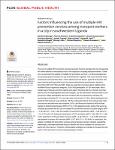Factors influencing the use of multiple HIV prevention services among transport workers in a city in southwestern Uganda

View/
Date
2023Author
Betunga, Benjamin
Atuhaire, Phionah
Nakasiita, Catherine
Kanyamuneza, Christa
Namiiro, Proscovia
Tugume, Joseph
Matovu, Hairat
Sark, Ahmed M.
Mugabi, Benedicto
Lilian, Birungi
Mugisha, Richard
Kumakech, Edward
Asiimwe, John Baptist
Metadata
Show full item recordAbstract
The use of multiple HIV prevention services has been found to decrease the risk of acquiring
HIV when tailored to individuals at risk of HIV exposure, including transport workers. There-
fore, we assessed the uptake of multiple HIV prevention services (�2) and associated fac-
tors among transport workers in a city in Southwestern Uganda. This cross-sectional study
comprised motorcycle taxi riders, motor vehicle and truck drivers, aged 18 to 55 years who
were selected and responded to an interviewer-administered questionnaire, between
November 2021 and February 2022. Data was analyzed using descriptive statistical and
modified Poisson regression analyses. Out of 420 participants, 97.6% were male, with a
median age of 28 years and the majority were aged <34 years (84.6%). Overall, less than
half (45.3%) of the participants had used multiple (�2) HIV prevention services within a one-
year period. Many participants had used condoms (32.2%) followed by voluntary HIV
counseling and testing (27.1%), and safe male circumcision (17.3%). Most participants who
tested for HIV had ever used condoms (16.2%), followed by those who received safe male
circumcision and had ever used condoms (15%), and those who tested for HIV and had
started on antiretroviral therapy (ART) (9.1%). In the adjusted model, factors that were sig-
nificantly associated with the use of multiple HIV prevention services included religion (aPR
= 1.25, 95% CI = 1.05–1.49), the number of concurrent sex partners (aPR = 1.33, 95% CI =
1.10–1.61), prior HIV testing and awareness of HIV serostatus (aPR = 0.55, 95% CI = 0.43–
0.70), awareness of HIV prevention services (aPR = 2.49, 95% CI = 1.16–5.38), and finan-
cial payment to access HIV services (aPR = 2.27, 95% CI = 1.47–3.49). In conclusion, the
uptake of multiple HIV prevention services among transport workers remains suboptimal.
Additionally, individual behavioral factors influence the use of multiple HIV services com-
pared with other factors. Therefore, differentiated strategies are needed to increase the utili-
zation of HIV prevention services among transport workers
URI
https://doi.org/10.1371/ journal.pgph.0001350http://ir.lirauni.ac.ug/xmlui/handle/123456789/512
Collections
- Research Articles [36]
